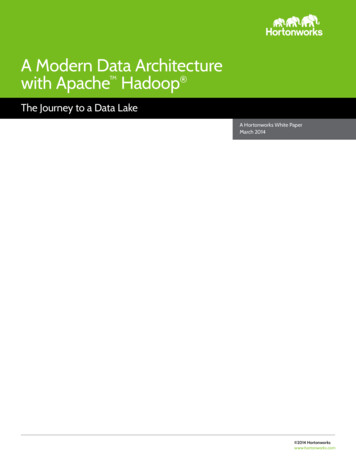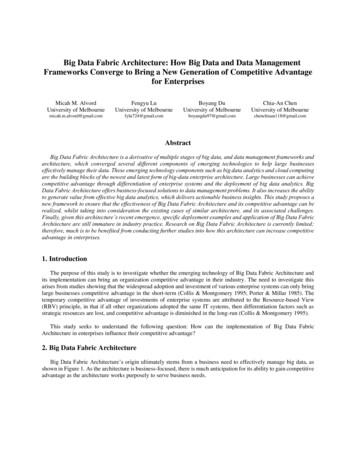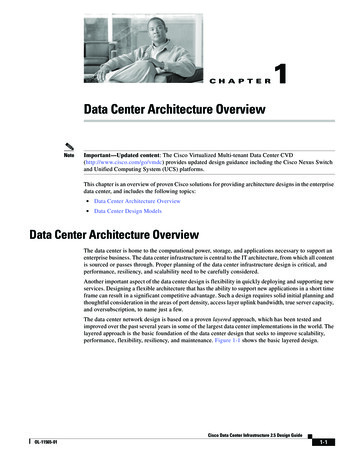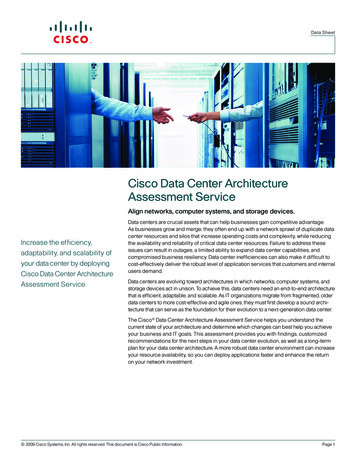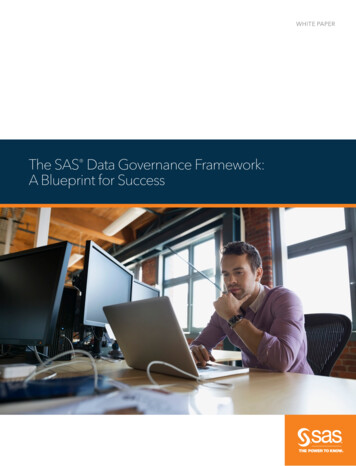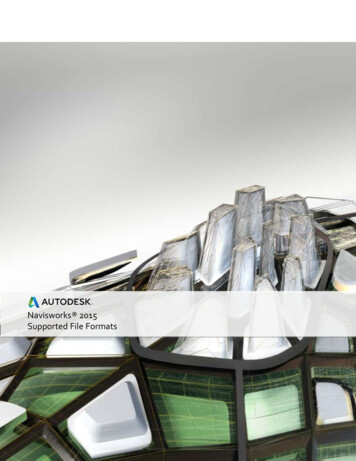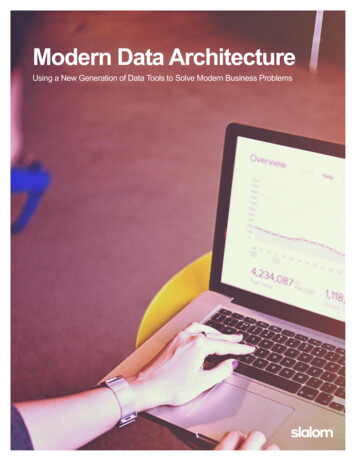
Transcription
Modern Data ArchitectureUsing a New Generation of Data Tools to Solve Modern Business Problems
Modern Data for a ModernWorldBig Data’s PromiseData is literally exploding. Every size and every shape and a speed that could not befathomed just a few years ago. Every industry and every company sees the value indata. Not just for a historical view of company performance but as a means to betterdetermine what products to sell to which customers, or to better predict the health of apatient in the future and what to do with it, or to layer on value added services andexperiences to product suites, data and the intelligence that we are deriving from it seemsto be the opportunity or promise that Business Intelligence practitioners have touted foryears.However, the realization of these promises has been far from realized to date. Reasonsfor this have not necessarily been the lack of the right statistics or algorithms to apply todata to better predict what is statistically significant enough to be call Intelligent (ArtificialIntelligence for that matter), but more the technology advancements from both a hardwareand software perspective. Coupling this with the investments in systems that captureinformation from more and more everyday experiences (Internet of Things), and we had agap between promise and reality.We can see the ways in which modern data is materializing in our everyday lives. Most ofus don’t recognize it, but it is there and implicitly we benefit from it.BiometricsOnline BehaviorsSmart EnergyUsageHealthManagementProductDevelopmentValue AddedConsumer ServicesFinally, excuses and lack of understanding are no more. Everything is wired andconnected from watches to clothes capturing biometric data, to physical ad displayscapturing our eye movements and behaviors, to our everyday online experiencescapturing our likes, dislikes and shopping behaviors. The investments have been madeand the software has come along side it to be able to store this data more cost effectivelyand rapidly. And the hardware has matured to be able to process this data more rapidlyso that patterns and intelligence can be applied and discerned. The combination of thedata’s existence coupled with our ability to store and process it means we can finallyapply our mathematical methods to gain insights from it. And if your company can takeadvantage of this triple threat, the promise of Big Data and Analytics can be realized to1
provide a competitive advantage to your competitors. And in today’s rapidly evolvingmarketplace, an unfair advantage off the starting line may be all you need to dominateyour segment.Why modern data architecture?With your organization collecting more data than ever before - from both existing and newdata sources your traditional data environments are probably starting to feel the squeeze.Capacity issues, long query times, and overly complex transformation processes are allthe result of the increase in available data. A study by the IDC estimates a 50x growth indata over the next 10 years1 with 28.1 Billion IoT devices are expected to be online by2020. All this while Forester tells us that only 12% of corporate data is actually beingleveraged with the amounts of data that corporations have collected today.50X 28.1 12%Data growth in next 10 years1Billion IoT devices by 20201of corporate data is actually used2Consider what that means for your organization: what business opportunities does thatcreate? How much strain will it put on your available resources to take advantage of thatopportunity?Is Modern Data the answer?Modern data architecture can give you answers. Think of it as a platform for solvingbusiness problems by deriving insight from data in high volume, high velocityenvironments.A modern data architecture establishes a framework and approach to data that allowspeople to make better decisions more quickly.We find that it also reduces the cost of failure by providing nimble data storage andprocessing solutions. And it allows organizations to be innovative in the way they utilizedata to meet changing needs, without the overhead of large solutions that aren’t relevantanymore.“If you want to increase innovation, you have to lower the cost of failure.” – Joi Ito,Director of MIT Media Lab2
Do you need a modern data architecture?Is a modern data architecture approach right for your business? If you can answer yes tomore than two of the following questions, you might consider it:1 Can information consumed by the organization answer today’s businessquestions and take into account all the relevant data?2 Could you make better decisions and respond more effectively if certaininformation were available in more rapidly?Do new data sources require significant changes to software or hardware?Do your highly valuable data science teams spend more time aggregatingdata or building models to predict behaviors, actions, and insights into thebusiness?3 4 What problems does modern data architecture solve?Modern data architecture addresses many of the problems associated with big data.What has become the classic description of what Modern Data is involves the 3V’s. Butwe would add a fourth that is required in order to obtain value out of the data that iscollecting collected:VolumeOrganizations are struggling with the costs of storage of existing data and processing ofnew data.VarietyNew data sources challenge enterprises with new formats or no format. There must be away to quickly and efficiently acquire and process new data.VelocityReal-time is becoming critical for enterprises. The line between Batch and Real-time isblurring and both people and applications need intelligence at the decision point.AnalyticsWith advances in processing and storage come increased ability to analyze, predict, andoptimize. Analytics at differing points provides the return to justify Modern DataArchitecture.Slalom’s approach to modern data architectureOur approach looks at the data ecosystem holistically, based on the needs of theorganization, and makes that data available when and where you want it.3
How do we see the cloud as a part of this conversation?Using a cloud platform isn't a requirement of these technologies but it can be an enabler.The variable pay and linear scale model is an attractive way to test out new solutions andthe integrated service layers are attractive to an organization that does not have the skillor bandwidth to quickly evaluate and architect these solutions in their on premiseenvironments. Coupling this with the fact that a very large portion of the new varieties ofdata are created from off premise systems or external to the company, the cloud can bean attractive approach to modern data and an accelerator to moving forward.Real-time SystemsHistorically real-time systems were completely contained within an application or given aspecific data storage environment to use allowing high speeds. Today, we needintegrated systems to make decisions that applications and business leaders depend on.Over the last decade the battle between data warehouse information vs. online datastorage systems (OLAP vs. OLTP) has caused us to rethink how we architect datasystems.This struggle has been the basis of solutions for organizations that need real-time insight.Tools and design principles in this space are maturing and gaining adoption quickly. This4
is not enough. Our approach includes an understanding of the operational details tocreate solutions that scale, are cost effective, and maintainable. Organizations thatleverage this type of architecture are seeing tangible business advantages. Gartner saysthat organizations leveraging modern information management can expect to outperformcompetitors by 20% by 2015.Analytics presents an even greater challenge. Analytics has been an offline process thatpresents insights in a highly latent way. Today, we need predicted outcomes minutes oreven seconds after the data is created. This requires new thinking and a modernarchitecture to support it.Batch ProcessingNew challenges in batch processing have made existing approaches challenging. Largedata volumes or multi-format data feeds create problems for traditional processes.Modern data architecture overcomes these challenges by providing ways to addressvolumes of data efficiently. Many of the tools developed to address big data have helpedto overcome this. But those tools need to be part of a strategy and architecture to beefficient.Multi-format or completely unstructured data requires an environment of discovery andanalysis before becoming part of the larger workflow. Modern architecture allows for thistype of investigation while maintaining environment integrity and efficiency.Analytics are most comfortable in the batch world, but we’re asking it to operate in a newfashion. Analysts and data scientists can’t wait until the data lands in the warehouse. Nowthey become part of the discovery process and tell us what data is important. The risk isthat these users are familiar with a data warehouse environment where databaseadministrators protect them from themselves. New approaches must provide some of thesame guardrails while allowing for their participation.What are the key differences between traditional and modernarchitectures?There are three main differentiators between the traditional and modern approaches:5SCALECOSTSPEEDScaling is an important part of amodern approach. In atraditional environment leadersare trying to stay ahead of thedemands for storage andprocessing power. The beauty ofa modern approach is that scaleis flexible and can be added orremoved whenever it’sappropriate. LegacyCosts are dependent on thedeployment model. Whenmodern data architecture isdeployed with some level ofcloud infrastructure, it can beused from proving ground forproduction concepts to a fullcloud production environment. Ifproduction environment needsare stable, cloud remains aIn a traditional environment, wehave become experts at derivinginsight from our pre-definedprocesses. Analysts and toolsare organized to allow datamanipulation and analysisquickly. The issues come fromnew data sources or formats thatkick off an IT project. These mustbe prioritized, scoped and turned
procurement processes increasethe cost of failure andinnovation. ata growth in next 10years1proving ground. The variablecosts rise and fall with theattempts for innovativesolutions. Conversely if theproduction environment isdynamic, the whole solution maylive on commodity hardware in acloud environment.into a solution. With a modernarchitecture, the tool-setexpands and processing isavailable as needed as thearchitecture is designed to beflexible. Modern dataarchitecture allows enterprises toingest new data quickly and get itin the hands of users orapplications to provide insight.How does Modern Data Architecture Work?Each component of a traditional data environment is challenged in new ways with thisdata explosion. A modern approach to these areas helps address their unique needs.ReportingGranularity is the lifeblood of reporting. Decision makers need a view of the metrics that isappropriate for their level of management. Providing the capability to quickly drill downinto the details given a large amount of data is where traditional environments canstruggle.Modern architectures provide options in the approach to reporting. Some organizationstake an aggregation approach while others want the power to build aggregates on the fly.Modern architecture accommodates either approach while allowing for speed ofprocessing, added data capacity, and ability to handle concurrent users.AnalyticsModern architectures solve analytics issues in batch and real-time scenarios. In batch,analysts need the ability to pull data together quickly. They also need the ability to decidewhat data is important. Modern approaches allow for the processing power to store vastamounts of data and organize it quickly to run predictive algorithms.Real-time analytics was barely available until now. Analytics is becoming part ofproduction applications. This means organizations must enable analytics to participate inthe software development lifecycle. Modern approaches allow analytics developers to testnot only the accuracy of the models but the speed and reliability.Big DataFor years we’ve heard that data is an organization’s greatest asset. We believe this to betruer today than ever before. The growing data volumes and velocity are stretching thelimits of traditional systems.Modern approaches allow us to economically store data and prioritize access based onusers, the age of the data, the subject area, etc. This approach helps organizations6
understand the value of the data and organizes it in a way that maximizes access to themost important data without sacrificing the added value of ancillary information.VisualizationAs the data visualization space continues to mature, it is important to understand theunique challenges that this type of processing and reporting poses. Modern approachesto data architecture allow visualizations to provide value through visual explorations of thedata as well as metric reporting, trending, and drill down.How Can Slalom help you design a modern dataarchitecture?Slalom brings a range of expertise to help clients achieve their data and insightsobjectives. Our MDA architects have worked in many Fortune 50 companies acrossindustries bringing the needed expertise to create systems that deliver results.Typical projects start with an in-depth analysis of the existing architecture to determinethe gaps that need to be addressed. Slalom helps clients design systems that not onlywork, but play nicely with existing infrastructure. Architects take into consideration morethan just the technology. New technologies require new skills. Organizations often vary intheir ability to take on new technology stacks. Crafting the right solution means utilizingtechnology that meets the client objectives but can also be supported by the organizationonce in place.After an architecture is agreed upon, Slalom delivers the solution incrementally. Typicallyutilizing an agile approach, Slalom consultants and engineers begin the build out. Thedelivery team can be setup in a number of ways including co-mingling clients withconsultants to build out the solution. This integrated approach helps organizations buildthe skills necessary to support the tools once the solution is built.Once the solution is complete, Slalom helps deliver insights. Slalom’s data science teamsare experts at utilizing traditional and modern tools to find answers to client’s hardestquestions. Quickly providing insight allows business owners an easy way to realize thereturn on their investment.7
Let’s get startedInterested in learning more about how a modern data architecture can help yourbusiness? Let’s connect.About the AuthorAdam Hood works on Slalom’s National Information Management and Analyticspractice where he is the Modern Data Architecture Solution Principle on that team.Adam’s background in Marketing Data and Analytics has allowed him to work with avariety of environments where Big Data is collected and Analytics are applied to it togain insights and advantages throughout the Customer Experience lifecycle.To learn more about Modern Data Architecture, contact Adam at adamh@slalom.com8
data volumes or multi-format data feeds create problems for traditional processes. Modern data architecture overcomes these challenges by providing ways to address volumes of data efficiently. Many of the tools developed to address big data have helped to overcome this. But those tools need to be part of a st

